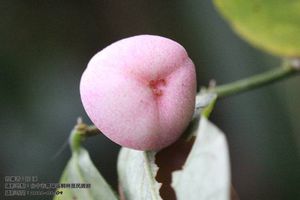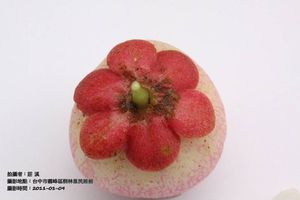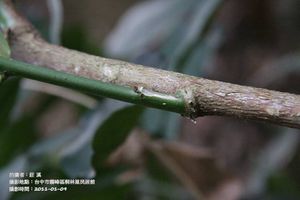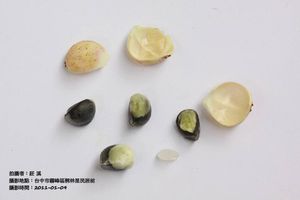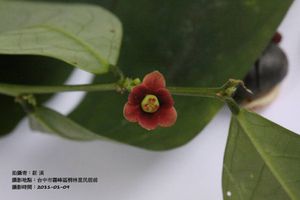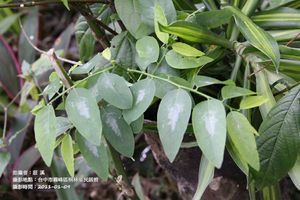守宮木
出自台灣有毒中草藥毒性資料庫
| (14個中途的修訂版本沒有顯示) | |||
| 第1行: | 第1行: | ||
__NOTOC__ | __NOTOC__ | ||
| - | [http://tcm-toxic.kmu.edu.tw/index.php/%E5%A4%A7%E6%88%9F%E7%A7%91 | + | {| |
| - | {{:模板:基本資料|1=大戟科 Euphorbiaceae|2=守宮木屬|3= 'Sauropus'|4=守宮木|5=''Sauropus | + | ||[http://tcm-toxic.kmu.edu.tw/index.php/%E5%AD%B8%E5%90%8D 中英文學名] |
| + | |||
| + | ||[http://tcm-toxic.kmu.edu.tw/index.php/%E5%A4%A7%E6%88%9F%E7%A7%91 科別] | ||
| + | |||
| + | ||[http://tcm-toxic.kmu.edu.tw/index.php/%E6%AF%92%E6%80%A7 毒性] | ||
| + | |||
| + | ||[http://tcm-toxic.kmu.edu.tw/index.php/%E7%97%87%E7%8B%80 症狀] | ||
| + | |} | ||
| + | {{:模板:基本資料|1=大戟科 Euphorbiaceae|2=守宮木屬|3= 'Sauropus'|4=守宮木|5=''Sauropus androgynus'' (Linn.) Merr.|6=Pak-Waan-Bann, Katuk, asin-asin, Chekor manis |7=減肥菜、剪肥菜、樹仔菜、越南菜、沙巴菜}} | ||
== '''植物圖片''' == | == '''植物圖片''' == | ||
| + | <font size=4> | ||
{| border="2" style="border-collapse;" | {| border="2" style="border-collapse;" | ||
|| | || | ||
| - | [[檔案: |300px| ]] | + | [[檔案:守宮木-果底1.JPG|300px| ]] |
| - | + | ||
| + | 守宮木果底 | ||
|| | || | ||
| - | [[檔案: |300px| ]] | + | [[檔案:守宮木-宿存萼1.JPG|300px| ]] |
| - | + | ||
| + | 守宮木宿存萼 | ||
|| | || | ||
| - | [[檔案: |300px| ]] | + | [[檔案:守宮木-莖1.JPG|300px| ]] |
| - | + | ||
| + | 守宮木莖 | ||
|| | || | ||
|- | |- | ||
|| | || | ||
| - | [[檔案: | + | [[檔案:守宮木-種子02.JPG|300px| ]] |
| - | + | ||
| + | 守宮木種子 | ||
|| | || | ||
| - | [[檔案: |300px| ]] | + | [[檔案:守宮木-雌花1.JPG|300px| ]] |
| - | + | ||
| + | 守宮木雌花 | ||
|| | || | ||
| - | [[檔案: | + | [[檔案:守宮木-葉3.JPG|300px| ]] |
| - | + | ||
| + | 守宮木葉 | ||
|} | |} | ||
| + | </font> | ||
== '''守宮木簡介''' == | == '''守宮木簡介''' == | ||
| - | <font size= | + | <font size=4> 守宮木主要源自於印尼,馬來西亞等地。在馬來西亞主要是作為民眾的日常生活主食之一,當地人稱之為Chekor manis或asin-asin[1],在泰國也被民眾用於一般的食用蔬菜[2],食用量均為小量食用。台灣在於1994年引進後,作為減肥用途的食品,廣受民眾使用,但陸續出現食用者出現肺部功能方面的問題,此一肺部功能問題也在日本發現案例[3-5]。此種肺部種肺部受損經病理檢查認定為阻塞性支氣管肺炎(Bronchiolotis obliterans),目前並無方法治療,且末期會導致肺部纖維化,必須進行肺臟移植[6],因此守宮木才被衛生署公告禁止販賣。一般民眾應注意盡可能不要再食用守宮木來來當做減肥的用途,以免產生嚴重後果。</font> |
| 第42行: | 第52行: | ||
{| border="2" style="border-collapse;" | {| border="2" style="border-collapse;" | ||
|| | || | ||
| - | <font size= | + | <font size=4>'''莖'''</font> |
| - | ||<font size= | + | ||<font size=4>灌木,高 1~3 公尺;小枝綠色,長而細,幼時上部具稜,老漸圓柱狀;全株均無毛。</font> |
|- | |- | ||
|| | || | ||
| - | <font size= | + | <font size=4>'''葉'''</font> |
| - | ||<font size= | + | ||<font size=4>葉片近膜質或薄紙質,卵狀披針形、長圓狀披針形或披針形,長 3~10 公分,寬 1.5~3.5 公分,頂端漸尖,基部楔形、圓或截形;側脈每邊 5~7 條,上面扁平,下面突起,網脈不明顯;葉柄長 0.2~0.4 公分;托葉 2,著生於葉柄基部兩側,長三角形或線狀披針形,長 0.15~0.3 公分。</font> |
|- | |- | ||
|| | || | ||
| - | <font size= | + | <font size=4>'''花'''</font> |
| - | ||<font size= | + | ||<font size=4> 雄花:1~2 朵腋生,或幾朵與雌花簇生於葉腋,直徑 0.2~1 公分;花梗鮮細,長 0.5~0.75 公分;花盤淺盤狀,直徑 0.5~1.2 公分,6 淺裂,裂片倒卵形,覆瓦狀排列,無退化雌蕊;雄花 3,花絲合生呈短柱狀,花藥外向,2 室,縱裂;花盤腺體 6,與萼片對生,上部向內彎而將花藥包圍;雌花:通常單生於葉腋;花梗長 0.6~0.8 公分;花萼 6 深裂,裂片紅色,倒卵形或倒卵狀三角形,長 0.5~0.6 公分,寬 0.3~0.55 公分,頂端鈍或圓,基部漸狹而成短爪,覆瓦狀排列;無花盤;雌蕊扁球狀,直徑約 0.15 公分,高約 0.07 公分,子房 3 室,每室 2 顆胚珠,花柱 3,頂端 2 裂。花期 4~7 月。</font> |
|- | |- | ||
|| | || | ||
| - | <font size= | + | <font size=4>'''果實'''</font> |
| - | ||<font size= | + | ||<font size=4> 蒴果扁球狀或圓球狀,直徑約 1.7 公分,高約 1.2 公分,乳白色帶粉紅色暈,宿存 6 瓣紅色花萼;果梗長 0.5~1 公分;種子三稜狀,長約 0.7 公分,寬約 0.5 公分,黑灰色帶有光澤。果期 7~12 月。</font> |
|} | |} | ||
| - | |||
== '''產地''' == | == '''產地''' == | ||
| - | <font size= | + | <font size=4> 菲律賓,印度,泰國,越南等東南亞地區</font> |
| - | + | ||
=='''使用情況'''== | =='''使用情況'''== | ||
| - | <font size= | + | <font size=4>東南亞地區,如菲律賓,泰國等地,以嫩枝嫩葉作為日常生活主食之一;根部可用於解熱,解毒或抗菌之用。在部分國家用於減肥用途,但大劑量會產生肺臟傷害。</font> |
| - | + | ||
| 第73行: | 第80行: | ||
{| border="2" style="border-collapse;" | {| border="2" style="border-collapse;" | ||
|| | || | ||
| - | <font size= | + | <font size=4>'''葉'''[2]</font> |
| - | ||<font size= | + | ||<font size=4> |
*1. papaverine (每公克內含0.58公克)</font> | *1. papaverine (每公克內含0.58公克)</font> | ||
|- | |- | ||
|| | || | ||
| - | <font size= | + | <font size=4>'''地上部分'''[7-10]</font> |
| - | ||<font size= | + | ||<font size=4> |
*1. lignan diglycoside ((-)-isolariciresinol 3α-O-β-apiofuranosyl-(1->2)-O-β-glucopyranoside) | *1. lignan diglycoside ((-)-isolariciresinol 3α-O-β-apiofuranosyl-(1->2)-O-β-glucopyranoside) | ||
*2. megastigmane glucoside (sauroposide) | *2. megastigmane glucoside (sauroposide) | ||
| 第88行: | 第95行: | ||
</font> | </font> | ||
|} | |} | ||
| + | |||
| + | |||
| + | =='''活性研究'''== | ||
| + | <font size=3> | ||
| + | *1. 分別給予泌乳期的BALB/C小鼠成熟及未成熟的守宮木葉萃取物,發現未成熟葉促進泌乳激素(prolactin)基因及催產素(oxytocin)基因表現量提高9.04和2.25倍,而成熟的葉萃取物則提高約15.75及25.77倍。推測可能與葉中所含的papaverine相關[11] | ||
| + | |||
| + | *2. 從守宮木中分離出的化合物3-O-β-D-glucosyl-(1→6)-β-D-glucosyl-kaempferol (GGK),以6及60 mg/kg經口連續給予Wistar大鼠28天,結果顯示在60 mg/kg組中,大鼠的進食量呈現15%的下降,而大鼠的體重,血中三酸甘油脂(triglyceride, TG),膽固醇(cholesterol)及丙氨酸氨基轉氨酶(alanine aminotransferase, ALT)在6及60 mg/kg劑量的組別當中均有顯著的下降。但在60 mg/kg的組別中,肺臟有輕微的間質性症狀出現[10]。 | ||
| + | </font> | ||
== '''毒性研究''' == | == '''毒性研究''' == | ||
| - | *<font size= | + | *<font size=4 color=green>'''症狀'''</font> <font size=4> |
| - | ** | + | **心律不整,噁心,嘔吐,便秘,腹瀉,頭暈,嗜睡,皮膚紅疹,呼吸困難,肺纖維化等[1, 2]</font> |
| - | </font> | + | |
| + | *<font size=4 color=green>'''有毒成分'''</font> <font size=4> | ||
| + | **未知</font> | ||
| - | *<font size= | + | *<font size=4 color=green>'''中毒劑量'''</font> <font size=4> |
| - | ** | + | **未知 |
| - | + | ||
</font> | </font> | ||
| - | *<font size= | + | *<font size=4 color=green>'''機轉'''</font> <font size=4> |
| - | <font size= | + | **未知 |
| - | + | ||
| - | + | ||
| - | + | ||
| - | + | ||
| - | + | ||
| - | + | ||
| - | + | ||
| - | + | ||
| - | ** | + | |
</font> | </font> | ||
| - | *<font size= | + | *<font size=4 color=green>'''肺臟毒性'''</font> <font size=4> |
| - | <font size= | + | **1. 經由分析得知守宮木葉的成分含有高量的papaverine[2],實驗分別口服給予Sprague-Dawley大鼠守宮木葉及papaverine的1倍,10倍及20倍的濃縮液,另外也以腹腔注射給予5及10倍的papaverine濃縮液,均無發現大鼠有任何肺部纖維化的現象,僅有輕微的發炎現象。此種結果可能因為是物種間的不同,而與臨床案例有不同的結果[12]。 |
| + | **2. 病患在連續服用守宮木後,總累積較高劑量(≥7200 g)的病患,所產生的阻塞性換氣障礙(obstructive ventilatory defect)的比率(13位, 48.1%)較低劑量(0-1799 g)的病患(4位, 9.3%)高。且在總試驗者當中有25.6% (49位)受試者罹患了中等至嚴重不同程度的阻塞性換氣障礙,且對支氣管擴張劑治療無反應,這49位當中又有65%的人在食用後7個月內,都產呼吸困難(dyspnea)的症狀,這些症狀在22個月的追蹤期內,都無法自行回復[13]。 | ||
| + | **3. 在食用守宮木,且出現呼吸道症狀的病患的肺部組織病理切片染色可觀察到T細胞的表現量遠高於B細胞,而血液中的腫瘤壞死因子alpha (TNF-α)也相對正常人明顯的上升。對於藥物(prednisolone及bronchodilator)的治療沒有顯著反應[14]。 | ||
</font> | </font> | ||
| + | |||
| + | *<font size=4 color=green>'''細胞毒性'''</font> <font size=4> | ||
| + | **1. EtOAc萃取物對於細胞生長有強烈的抑制現象,而n-BuOH及EtOAc萃取物可觀察到染色質濃縮(chromatin condensation)及細胞凋亡(apoptosis)。細胞壞死(necrosis)也可在CHCl3及EtOAc組內看到[15]。</font> | ||
| + | |||
| + | *<font size=4 color=green>'''基因毒性'''</font> <font size=4> | ||
| + | **1. 守宮木萃取液給予中國倉鼠肺成纖維細胞(CHL)及中國倉鼠肺細胞(V79),發現50%的守宮木萃取液在CHL上,未經肝臟酵素代謝會對CHL產生極為明顯的染色體突變[16]。</font> | ||
| + | |||
=='''毒性分級'''== | =='''毒性分級'''== | ||
| - | <font size= | + | <font size=4>[http://tcm-toxic.kmu.edu.tw/index.php/%E6%AF%92%E6%80%A7%E5%88%86%E9%A1%9E 級數B, 等級2]</font> |
== '''參考文獻''' == | == '''參考文獻''' == | ||
| - | <font size= | + | <font size=4> |
| - | 1. | + | 1. 林增記, 江大雄, 謝義山, 李明儀, 陳俊達, 陳宏吉, 施怡如, 許世昌, 鄧昭芳. [http://www.ceps.com.tw/ec/ecjnlarticleView.aspx?jnlcattype=0&jnlptype=0&jnltype=0&jnliid=483&issueiid=2793&atliid=24139 減肥菜之中毒事件]. ''疫情報導'' 1996; 12: 68-73. |
| - | 2. | + | 2. Padmavathi P, Rao MP. [http://www.ncbi.nlm.nih.gov/pubmed/2385571 Nutritive value of Sauropus androgynus leaves.] ''Plant foods for human nutrition'' 1990; 40: 107-113. |
| - | 3. | + | 3. Sawahata M, Ogura T, Tagawa A, Takahashi H, Yazawa T, Matsuura M, Takemura T. [http://www.sciencedirect.com/science/article/pii/S1755001709001109 Sauropus androgynus-associated bronchiolitis obliterans of mother and daughter – autopsy report.] ''Respiratory Medicine CME'' 2010; 3: 214-217. |
| - | 4. | + | 4. Ger LP, Chiang AA, Lai RS, Chen SM, Tseng CJ. [http://aje.oxfordjournals.org/content/145/9/842.short Association of Sauropus androgynus and bronchiolitis obliterans syndrome: a hospital-based case-control study.] ''American Journal of Epidemiology'' 1997; 145: 842-849. |
| - | 5. | + | 5. Oonakahara K, Matsuyama W, Higashimoto I, Machida K, Kawabata M, Arimura K, Osame M, Hayashi M, Ogura T, Imaizumi K, Hasegawa Y. [http://www.ncbi.nlm.nih.gov/pubmed/15824537 Outbreak of Bronchiolitis obliterans associated with consumption of Sauropus androgynus in Japan--alert of food-associated pulmonary disorders from Japan.] ''Respiration'' 2005; 72: 221. |
| - | 6. | + | 6. Luh SP, Lee YC, Chang YL, Wu HD, Kuo SH, Chu SH. [http://www.ncbi.nlm.nih.gov/pubmed/10617240 Lung transplantation for patients with end-stage Sauropus androgynus-induced bronchiolitis obliterans (SABO) syndrome.] ''Clinical Transplantation'' 1999; 13: 496-503. |
| - | 7. | + | 7. Kanchanapoom T, Chumsri P, Kasai R, Otsuka H, Yamasaki K. [http://www.ncbi.nlm.nih.gov/pubmed/12895550 Lignan and megastigmane glycosides from Sauropus androgynus.] ''Phytochemistry'' 2003; 63: 985-988. |
| - | 8. | + | 8. Miean KH, Mohamed S. [http://www.ncbi.nlm.nih.gov/pubmed/11410016 Flavonoid (myricetin, quercetin, kaempferol, luteolin, and apigenin) content of edible tropical plants.] ''Journal of Agricultural and Food Chemistry'' 2001; 49: 3106-3112. |
| - | 9. | + | 9. Andarwulan N, Batari R, Sandrasari DA, Bolling B, Wijaya N. [http://www.google.com/url?sa=t&rct=j&q=Flavonoid+content+and+antioxidant+activity+of+vegetables+from+Indonesia&source=web&cd=1&ved=0CFUQFjAA&url=http%3A%2F%2Fnaldc.nal.usda.gov%2Fdownload%2F41822%2FPDF&ei=-mPMT4rqJO-fmQXc2KzsDg&usg=AFQjCNHoo5errisnx1dIpbPunTnp3hfGBw&sig2=PnJM6Cn8qFS3RXTGb0MWDw Flavonoid content and antioxidant activity of vegetables from Indonesia]. ''Food Chemistry'' 2010; 121: 1231-1235. |
| - | 10. | + | 10. Yu SF, Shun CT, Chen TM, Chen YH. [http://www.ncbi.nlm.nih.gov/pubmed/17142992 3-O-beta-D-glucosyl-(1-->6)-beta-D-glucosyl-kaempferol isolated from Sauropus androgenus reduces body weight gain in Wistar rats.] ''Biological & pharmaceutical bulletin'' 2006; 29: 2510-2513. |
| - | 11. | + | 11. Soka S, Alam H, Boenjamin N, Agustina TW, Suhartono MT. [http://www.ncbi.nlm.nih.gov/pubmed/20798550 Effect of Sauropus androgynus leaf extracts on the expression of prolactin and oxytocin genes in lactating BALB/C mice.] ''Journal of Nutrigenetics and Nutrigenomics'' 2010; 3: 31-36. |
| + | |||
| + | 12. Lai RS, Wang JS, Lee PC. [http://www.ncbi.nlm.nih.gov/pubmed/10934806 Sauropus androgynus and papaverine do not induce bronchiolitis obliterans in Sprague-Dawley rats.] ''Zhonghua Yi Xue Za Zhi (Taipei)'' 2000; 63: 536-541. | ||
| + | |||
| + | 13. Hsiue TR, Guo YL, Chen KW, Chen CW, Lee CH, Chang HY. [http://www.ncbi.nlm.nih.gov/pubmed/9440571 Dose-response relationship and irreversible obstructive ventilatory defect in patients with consumption of Sauropus androgynus.] ''Chest'' 1998; 113: 71-76. | ||
| + | |||
| + | 14. Lai RS, Chiang AA, Wu MT, Wang JS, Lai NS, Lu JY, Ger LP, Roggli V. [http://www.ncbi.nlm.nih.gov/pubmed/8676721 Outbreak of bronchiolitis obliterans associated with consumption of Sauropus androgynus in Taiwan.] ''Lancet'' 1996; 348: 83-85. | ||
| + | |||
| + | 15. Yu SF, Chen TM, Chen YH. [http://www.ncbi.nlm.nih.gov/pubmed/17660143 Apoptosis and necrosis are involved in the toxicity of Sauropus androgynus in an in vitro study.] ''Journal of the Formosan Medical Association'' 2007; 106: 537-547. | ||
| + | |||
| + | 16. 張靜, 熊習昆, 楊穎, 王京濱, 陳秀娟. [http://www.ceps.com.tw/ec/ecjnlarticleView.aspx?jnlcattype=0&jnlptype=0&jnltype=0&jnliid=1548&issueiid=80165&atliid=1546605 守宮木致CHL及V79細胞染色體畸變作用.] ''中國公共衛生'' 2009; 25: 327-329. | ||
</font> | </font> | ||
| - | [http://tcm-toxic.kmu.edu.tw/index.php/%E5%A4%A7%E6%88%9F%E7%A7%91 | + | {| |
| + | ||[http://tcm-toxic.kmu.edu.tw/index.php/%E5%AD%B8%E5%90%8D 中英文學名] | ||
| + | |||
| + | ||[http://tcm-toxic.kmu.edu.tw/index.php/%E5%A4%A7%E6%88%9F%E7%A7%91 科別] | ||
| + | |||
| + | ||[http://tcm-toxic.kmu.edu.tw/index.php/%E6%AF%92%E6%80%A7 毒性] | ||
| + | |||
| + | ||[http://tcm-toxic.kmu.edu.tw/index.php/%E7%97%87%E7%8B%80 症狀] | ||
| + | |} | ||
在2012年7月3日 (二) 17:24的最新修訂版本
| 中英文學名 | 科別 | 毒性 | 症狀 |
基本資料
|
科別 | 大戟科 Euphorbiaceae |
|
屬名 | 守宮木屬 Sauropus |
|
中文學名 | 守宮木 |
|
拉丁學名 | Sauropus androgynus (Linn.) Merr. |
|
英文名稱 | Pak-Waan-Bann, Katuk, asin-asin, Chekor manis |
|
中文俗名 | 減肥菜、剪肥菜、樹仔菜、越南菜、沙巴菜 |
植物圖片
|
守宮木果底 |
守宮木宿存萼 |
守宮木莖 | |
|
守宮木種子 |
守宮木雌花 |
守宮木葉 |
守宮木簡介
守宮木主要源自於印尼,馬來西亞等地。在馬來西亞主要是作為民眾的日常生活主食之一,當地人稱之為Chekor manis或asin-asin[1],在泰國也被民眾用於一般的食用蔬菜[2],食用量均為小量食用。台灣在於1994年引進後,作為減肥用途的食品,廣受民眾使用,但陸續出現食用者出現肺部功能方面的問題,此一肺部功能問題也在日本發現案例[3-5]。此種肺部種肺部受損經病理檢查認定為阻塞性支氣管肺炎(Bronchiolotis obliterans),目前並無方法治療,且末期會導致肺部纖維化,必須進行肺臟移植[6],因此守宮木才被衛生署公告禁止販賣。一般民眾應注意盡可能不要再食用守宮木來來當做減肥的用途,以免產生嚴重後果。
外觀簡述
|
莖 | 灌木,高 1~3 公尺;小枝綠色,長而細,幼時上部具稜,老漸圓柱狀;全株均無毛。 |
|
葉 | 葉片近膜質或薄紙質,卵狀披針形、長圓狀披針形或披針形,長 3~10 公分,寬 1.5~3.5 公分,頂端漸尖,基部楔形、圓或截形;側脈每邊 5~7 條,上面扁平,下面突起,網脈不明顯;葉柄長 0.2~0.4 公分;托葉 2,著生於葉柄基部兩側,長三角形或線狀披針形,長 0.15~0.3 公分。 |
|
花 | 雄花:1~2 朵腋生,或幾朵與雌花簇生於葉腋,直徑 0.2~1 公分;花梗鮮細,長 0.5~0.75 公分;花盤淺盤狀,直徑 0.5~1.2 公分,6 淺裂,裂片倒卵形,覆瓦狀排列,無退化雌蕊;雄花 3,花絲合生呈短柱狀,花藥外向,2 室,縱裂;花盤腺體 6,與萼片對生,上部向內彎而將花藥包圍;雌花:通常單生於葉腋;花梗長 0.6~0.8 公分;花萼 6 深裂,裂片紅色,倒卵形或倒卵狀三角形,長 0.5~0.6 公分,寬 0.3~0.55 公分,頂端鈍或圓,基部漸狹而成短爪,覆瓦狀排列;無花盤;雌蕊扁球狀,直徑約 0.15 公分,高約 0.07 公分,子房 3 室,每室 2 顆胚珠,花柱 3,頂端 2 裂。花期 4~7 月。 |
|
果實 | 蒴果扁球狀或圓球狀,直徑約 1.7 公分,高約 1.2 公分,乳白色帶粉紅色暈,宿存 6 瓣紅色花萼;果梗長 0.5~1 公分;種子三稜狀,長約 0.7 公分,寬約 0.5 公分,黑灰色帶有光澤。果期 7~12 月。 |
產地
菲律賓,印度,泰國,越南等東南亞地區
使用情況
東南亞地區,如菲律賓,泰國等地,以嫩枝嫩葉作為日常生活主食之一;根部可用於解熱,解毒或抗菌之用。在部分國家用於減肥用途,但大劑量會產生肺臟傷害。
活性成份
|
葉[2] |
|
|
地上部分[7-10] |
|
活性研究
- 1. 分別給予泌乳期的BALB/C小鼠成熟及未成熟的守宮木葉萃取物,發現未成熟葉促進泌乳激素(prolactin)基因及催產素(oxytocin)基因表現量提高9.04和2.25倍,而成熟的葉萃取物則提高約15.75及25.77倍。推測可能與葉中所含的papaverine相關[11]
- 2. 從守宮木中分離出的化合物3-O-β-D-glucosyl-(1→6)-β-D-glucosyl-kaempferol (GGK),以6及60 mg/kg經口連續給予Wistar大鼠28天,結果顯示在60 mg/kg組中,大鼠的進食量呈現15%的下降,而大鼠的體重,血中三酸甘油脂(triglyceride, TG),膽固醇(cholesterol)及丙氨酸氨基轉氨酶(alanine aminotransferase, ALT)在6及60 mg/kg劑量的組別當中均有顯著的下降。但在60 mg/kg的組別中,肺臟有輕微的間質性症狀出現[10]。
毒性研究
- 症狀
- 心律不整,噁心,嘔吐,便秘,腹瀉,頭暈,嗜睡,皮膚紅疹,呼吸困難,肺纖維化等[1, 2]
- 有毒成分
- 未知
- 中毒劑量
- 未知
- 機轉
- 未知
- 肺臟毒性
- 1. 經由分析得知守宮木葉的成分含有高量的papaverine[2],實驗分別口服給予Sprague-Dawley大鼠守宮木葉及papaverine的1倍,10倍及20倍的濃縮液,另外也以腹腔注射給予5及10倍的papaverine濃縮液,均無發現大鼠有任何肺部纖維化的現象,僅有輕微的發炎現象。此種結果可能因為是物種間的不同,而與臨床案例有不同的結果[12]。
- 2. 病患在連續服用守宮木後,總累積較高劑量(≥7200 g)的病患,所產生的阻塞性換氣障礙(obstructive ventilatory defect)的比率(13位, 48.1%)較低劑量(0-1799 g)的病患(4位, 9.3%)高。且在總試驗者當中有25.6% (49位)受試者罹患了中等至嚴重不同程度的阻塞性換氣障礙,且對支氣管擴張劑治療無反應,這49位當中又有65%的人在食用後7個月內,都產呼吸困難(dyspnea)的症狀,這些症狀在22個月的追蹤期內,都無法自行回復[13]。
- 3. 在食用守宮木,且出現呼吸道症狀的病患的肺部組織病理切片染色可觀察到T細胞的表現量遠高於B細胞,而血液中的腫瘤壞死因子alpha (TNF-α)也相對正常人明顯的上升。對於藥物(prednisolone及bronchodilator)的治療沒有顯著反應[14]。
- 細胞毒性
- 1. EtOAc萃取物對於細胞生長有強烈的抑制現象,而n-BuOH及EtOAc萃取物可觀察到染色質濃縮(chromatin condensation)及細胞凋亡(apoptosis)。細胞壞死(necrosis)也可在CHCl3及EtOAc組內看到[15]。
- 基因毒性
- 1. 守宮木萃取液給予中國倉鼠肺成纖維細胞(CHL)及中國倉鼠肺細胞(V79),發現50%的守宮木萃取液在CHL上,未經肝臟酵素代謝會對CHL產生極為明顯的染色體突變[16]。
毒性分級
參考文獻
1. 林增記, 江大雄, 謝義山, 李明儀, 陳俊達, 陳宏吉, 施怡如, 許世昌, 鄧昭芳. 減肥菜之中毒事件. 疫情報導 1996; 12: 68-73.
2. Padmavathi P, Rao MP. Nutritive value of Sauropus androgynus leaves. Plant foods for human nutrition 1990; 40: 107-113.
3. Sawahata M, Ogura T, Tagawa A, Takahashi H, Yazawa T, Matsuura M, Takemura T. Sauropus androgynus-associated bronchiolitis obliterans of mother and daughter – autopsy report. Respiratory Medicine CME 2010; 3: 214-217.
4. Ger LP, Chiang AA, Lai RS, Chen SM, Tseng CJ. Association of Sauropus androgynus and bronchiolitis obliterans syndrome: a hospital-based case-control study. American Journal of Epidemiology 1997; 145: 842-849.
5. Oonakahara K, Matsuyama W, Higashimoto I, Machida K, Kawabata M, Arimura K, Osame M, Hayashi M, Ogura T, Imaizumi K, Hasegawa Y. Outbreak of Bronchiolitis obliterans associated with consumption of Sauropus androgynus in Japan--alert of food-associated pulmonary disorders from Japan. Respiration 2005; 72: 221.
6. Luh SP, Lee YC, Chang YL, Wu HD, Kuo SH, Chu SH. Lung transplantation for patients with end-stage Sauropus androgynus-induced bronchiolitis obliterans (SABO) syndrome. Clinical Transplantation 1999; 13: 496-503.
7. Kanchanapoom T, Chumsri P, Kasai R, Otsuka H, Yamasaki K. Lignan and megastigmane glycosides from Sauropus androgynus. Phytochemistry 2003; 63: 985-988.
8. Miean KH, Mohamed S. Flavonoid (myricetin, quercetin, kaempferol, luteolin, and apigenin) content of edible tropical plants. Journal of Agricultural and Food Chemistry 2001; 49: 3106-3112.
9. Andarwulan N, Batari R, Sandrasari DA, Bolling B, Wijaya N. Flavonoid content and antioxidant activity of vegetables from Indonesia. Food Chemistry 2010; 121: 1231-1235.
10. Yu SF, Shun CT, Chen TM, Chen YH. 3-O-beta-D-glucosyl-(1-->6)-beta-D-glucosyl-kaempferol isolated from Sauropus androgenus reduces body weight gain in Wistar rats. Biological & pharmaceutical bulletin 2006; 29: 2510-2513.
11. Soka S, Alam H, Boenjamin N, Agustina TW, Suhartono MT. Effect of Sauropus androgynus leaf extracts on the expression of prolactin and oxytocin genes in lactating BALB/C mice. Journal of Nutrigenetics and Nutrigenomics 2010; 3: 31-36.
12. Lai RS, Wang JS, Lee PC. Sauropus androgynus and papaverine do not induce bronchiolitis obliterans in Sprague-Dawley rats. Zhonghua Yi Xue Za Zhi (Taipei) 2000; 63: 536-541.
13. Hsiue TR, Guo YL, Chen KW, Chen CW, Lee CH, Chang HY. Dose-response relationship and irreversible obstructive ventilatory defect in patients with consumption of Sauropus androgynus. Chest 1998; 113: 71-76.
14. Lai RS, Chiang AA, Wu MT, Wang JS, Lai NS, Lu JY, Ger LP, Roggli V. Outbreak of bronchiolitis obliterans associated with consumption of Sauropus androgynus in Taiwan. Lancet 1996; 348: 83-85.
15. Yu SF, Chen TM, Chen YH. Apoptosis and necrosis are involved in the toxicity of Sauropus androgynus in an in vitro study. Journal of the Formosan Medical Association 2007; 106: 537-547.
16. 張靜, 熊習昆, 楊穎, 王京濱, 陳秀娟. 守宮木致CHL及V79細胞染色體畸變作用. 中國公共衛生 2009; 25: 327-329.
| 中英文學名 | 科別 | 毒性 | 症狀 |
